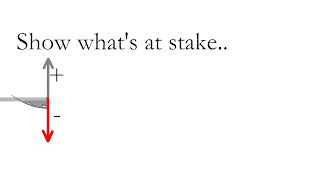And the journey begins with a single step.
It's now time to map our story journey. First we introduce our audience to a world of our own making. It can be "just like life" or something totally imaginary, the stuff of dreams.
Into this world we'll need some characters. Otherwise, it would just be a travelog. We need a very special kind of character. We don't have to love them at first. But we do have to be able to relate to them and maybe even understand them.
We'll be talking more about characters as well as the infamous expression, "Your story needs to be character driven" later, but for now we're just introducing the map. Later we'll also see how to actually use it to map, weave and write your own story.
We need to introduce a conflict into our world that causes problems for our character. They have problems and they want things, in other words, they have goals.
As we continue along our X axis timeline, we'll need to provide the audience with images of what's at stake in this story for our characters.
They need to see what can happen if the character succeeds and what can happen if they fail. These I had defined as good and bad. However it's more useful to us as storytellers if we redefine these as HOPE and FEAR.
Why HOPE and FEAR? Good and bad aren't really emotional. Hope and fear are emotional.
What do we do when we watch a movie? We identify with the characters as well as many other things. We identify what we're looking at and make sense of what's happening with the story. We make guesses as to what will happen. We expect things to happen and anticipate them. And we feel along with the characters.
And if the characters go up and down because they're hoping to reach their goal and fearing the worst then your audience will be going on the same journey! They'll be rooting and hoping for your characters to succeed and fearing that they won't. AND IT'S YOUR JOB TO PUT IN THE TWISTS AND BUMPS ALONG THE WAY!
So does this mean that we're actually directing what they should feel?
Of course it does.
And what if that ride mirrors the process of psychological growth and change?
Is that why we watch, without realizing it? And you thought you were going for the car chases.
Now, I've had some students object that this is manipulation. My response is of course it is. That's what the audience is paying us for! To give them a thrilling ride.
You are indirectly directing their emotions. You can't direct someone's emotions directly, can you? No, you have to do it indirectly by constructing meanings that will evoke feelings. *
With great power comes great responsibility! Direct wisely.
The audience then gets their seat right next to the star whom they identify with and go on the roller coaster of hope and fear. I originally conceived hope and fear as a pendulum swinging back and forth. This concept has gone through an evolution as I developed this new mapping approach.
Next blog, we'll continue the second stage of our journey over time riding up and down with our hopes and fears.
* {You can read more about directing the audience's emotions in my book, Directing the Story: Professional Storytelling and Storyboarding Techniques of Live Action and Animation. 2008 from Focal Press.}














"With great power comes great responsibility! Direct wisely." What a great line and one that all those involved in creating, producing and broadcasting media should take to heart. That said the whole post was highly informative and constructive - excellent work.
ReplyDelete